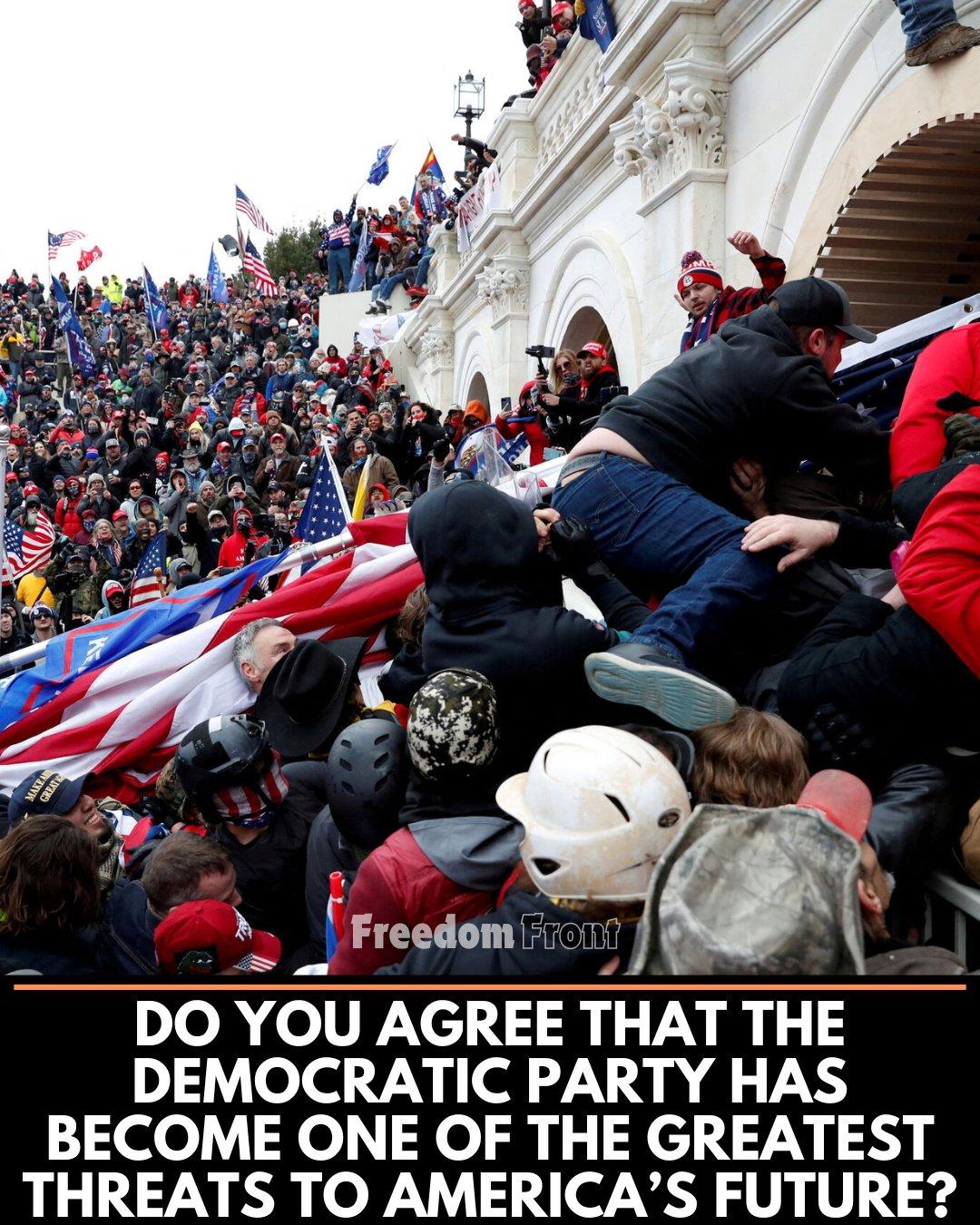
The image is seared into the nation’s consciousness—hundreds of people storming the U.S. Capitol on January 6, 2021, waving American flags, wearing political insignia, and breaching the very symbol of American democracy. It was a moment that shocked the world, exposed deep fractures in the political fabric of the United States, and left many wondering: how did we get here?
Accompanying this viral image is a bold and provocative question: “Do you agree that the Democratic Party has become one of the greatest threats to America’s future?” It is a query that reflects not just partisanship, but the escalating war of narratives between political ideologies. But to answer it, or even to entertain it responsibly, we must first understand the broader landscape—one shaped by misinformation, institutional distrust, and mutual suspicion between the two major political parties.
The Rise of Hyper-Partisanship in American Politics
In recent decades, political discourse in the U.S. has transitioned from debate to division. Both Democrats and Republicans have become increasingly tribal in their loyalties. Pew Research data shows that partisanship is at a 30-year high, with members of each party seeing the other not just as opponents, but as threats to the nation.
This shift didn’t happen overnight. Fueled by 24/7 news cycles, social media echo chambers, and increasingly provocative political rhetoric, Americans are often exposed to radically different realities depending on where they get their news or who they follow online.
January 6 and the Weaponization of Fear
The January 6 insurrection didn’t emerge in a vacuum. It was the result of months of disinformation, failed legal challenges, and persistent claims that the 2020 election was stolen. These beliefs were perpetuated by key Republican figures, amplified through digital platforms, and embraced by segments of the population that felt unheard, angry, and disillusioned.
While some blame the Republican Party for stoking the flames, others argue that the Democratic Party contributed to national unrest through restrictive mandates, perceived overreach on social issues, and support for controversial policies. This is where the image and caption provoke discussion: Is the Democratic Party responsible for pushing the nation toward a political cliff?
That question depends heavily on perspective—and how one defines “threat.”
Accusations Against the Democratic Party: Legitimate Critique or Political Spin?
Critics of the Democratic Party often point to several key issues:
Government Overreach: During the COVID-19 pandemic, many Democratic-led states implemented strict lockdowns and mandates. Some citizens saw these as necessary precautions; others viewed them as unconstitutional power grabs.
Culture Wars and Identity Politics: Opponents argue that the party has become overly focused on race, gender, and equity-based policies, alienating moderate and conservative voices in the process.
Economic Policies: Critics claim that progressive taxation, increased spending, and student debt relief proposals will balloon the national deficit and punish economic success.
Border and Immigration Control: The Democratic approach to immigration has drawn ire from conservatives, who see lax border enforcement as a national security risk.
However, for supporters of the Democratic Party, these same actions represent progress, inclusivity, and modern governance. They argue that:
Public health mandates saved lives
Identity-based legislation addresses centuries of systemic inequality
Economic reform is needed to reduce wealth gaps
Humane immigration policies align with American values
So, is the Democratic Party a threat—or simply a different vision for the country?
The Role of the Media in Shaping Perception
Media bias plays a massive role in shaping how political parties are viewed. Right-wing media outlets often paint Democrats as socialists or authoritarians, while left-wing outlets highlight Republican extremism, white nationalism, and anti-democratic tendencies.
This media echo chamber is dangerous. When Americans no longer share a common understanding of facts, democracy suffers. Without truth as a shared foundation, every policy becomes a battle. Every election becomes a war. Every political difference becomes a threat.
This is precisely how extremism flourishes.
A More Nuanced View: Both Parties Bear Responsibility
The idea that one party alone is responsible for America’s decline oversimplifies a complex reality. Both the Democratic and Republican parties have made strategic and moral miscalculations over the past two decades.
Republicans, under Trump, eroded institutional norms and politicized the judiciary
Democrats, at times, have dismissed concerns from rural, working-class communities, furthering a cultural divide
Rather than pointing fingers, perhaps it is time to reflect on the bipartisan erosion of civility, the overreliance on party loyalty, and the failure to address shared national concerns like healthcare, education, climate change, and infrastructure.
Can the U.S. Heal Its Political Divide?
Healing requires accountability—but also empathy. Blaming one party for all of America’s problems creates a false binary and ignores the role of citizen engagement, media manipulation, and systemic shortcomings.
Rebuilding national unity requires:
Restoring trust in institutions
Fostering bipartisan dialogue
Combatting disinformation
Prioritizing shared values over partisan wins
The future of the United States will not be saved or destroyed by one party alone—it will be determined by whether the American people can resist the forces of division and remember that democracy demands both disagreement and unity.
Final Thoughts: A Dangerous Question or a Necessary One?
The caption “Do you agree that the Democratic Party has become one of the greatest threats to America’s future?” is undoubtedly loaded, perhaps intentionally so. While it raises eyebrows, it also forces a larger question: Who is truly responsible for protecting the Republic?
The answer isn’t found in slogans, tweets, or viral images—but in the actions of everyday Americans who choose to think critically, vote consciously, and engage with empathy.




